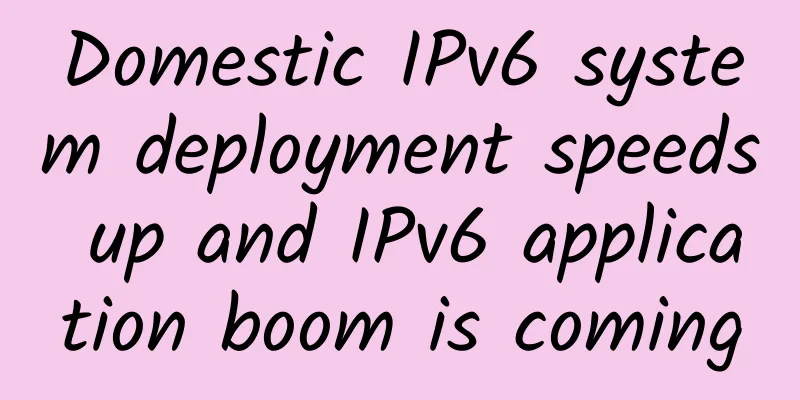How will network reconstruction proceed in the future?

|
Network reconstruction is intended to overturn the network architecture that has been developed for decades. As the most closed part of the data center, the network has not changed much for decades. The old OSPF/VRRP/STP protocols are still widely used even today. Although they have obvious limitations, there is still no technology that can completely replace them. Network reconstruction means abandoning those old technologies, opening a new page for the network, improving network forwarding performance, and empowering the network. The arrival of new technologies such as cloud computing, big data, and artificial intelligence has already put pressure on the network. It is just right to take advantage of these new technologies to launch network reconstruction. Network reconstruction is a big topic that many people have mentioned, and different people have different understandings of it. The network needs to change, but there are many opinions on how to change it and what it will look like. In summary, there are three main directions of change in network reconstruction: SDN, NFV, and 5G.
On-demand network based on SDN SDN is familiar to everyone and has become a bit of a cliché. If data centers do not try SDN, they will be left behind. SDN is definitely a reconstruction of the network and has completely changed the traditional network operation mode. SDN uses software-defined methods to reconstruct the network, allowing the network to change dynamically in real time according to application and business needs, greatly improving network operation and maintenance efficiency and reducing operation and maintenance costs. In addition, SDN opens up network capabilities and allows data center users to define networks according to their business needs, thus realizing network as a service, on-demand network, and on-demand bandwidth, which is exactly the network architecture that the cloud needs most. On-demand network means allocating network resources according to demand. SDN can achieve on-demand allocation of network resources, and this allocation is automatic, without human intervention, and is uniformly allocated by the controller. For example, if we want to apply for broadband at home, we need to go to the business hall to apply, sign a contract, and pay the fee. With on-demand network, we can adjust the bandwidth according to our needs, which is very convenient. In traditional networks, due to the fixed allocation of bandwidth and network ports, such adjustments require modifying the configuration of network equipment, so it is necessary to submit it to the business hall and wait for one or two days to complete the adjustment. In SDN's on-demand network, this is no longer necessary. The network bandwidth is adjusted completely according to user needs, which not only saves users' worries, but also saves data centers' efforts. Operators can't wait to launch such networks. However, the promotion of SDN has not been smooth. Because it may affect the profits of network equipment vendors, equipment vendors have no motivation to promote it. SDN has greatly reduced the number of network operation and maintenance personnel required, and data centers and operators also lack motivation, so the overall SDN practice has progressed slowly. Of course, network reconstruction is not only SDN, there are other options, which is also something that data centers and operators are considering. Whether to deploy SDN on a large scale or not, we will have to wait and see. NFV-based cloud network NFV is a network virtualization technology proposed by operators. Operators tend to abandon bulky and expensive dedicated network equipment and use standard IT virtualization technology to split network function modules. NFV covers a wider range of content than SDN, including core network, mainly including vEPC, vIMS, vPCRF, etc.; edge and aggregation network equipment, such as vBNG/vBRAS, vSBC, vCDN, etc.; customer-oriented innovative services, such as vCPE, SD-WAN, Live-TV (Swiss Telecom), etc.; these functions were originally implemented by dedicated equipment, but this not only makes the equipment expensive, but also very inflexible to operate, and not convenient for business adjustment and deployment. The use of NFV is different. All technologies are based on servers and implemented by software simulation. If the performance is not enough, additional servers can be added. With distributed technology, cheap servers plus a software can replace devices in different network locations. This is not good news for those network equipment manufacturers. Domestic operators also attach great importance to the development of NFV technology and have planned top-level strategic ideas for NFV, such as China Mobile's NovoNet2020 vision, China Unicom's CUBE-Net strategy, and China Telecom's CTNet2025 network architecture white paper. As a key technology for network reconstruction, NFV is difficult and complex, and large-scale commercial use in the future is a long way to go. Obviously, operators are ready to continue on the road of NFV. Rapid development and promotion of 5G networks Compared with 2G, 3G, and 4G networks, 5G is more than just bandwidth improvement. In the 5G era, the Internet of Things and mobile communication network services will be integrated, giving rise to three typical applications including enhanced mobile broadband (eMBB), massive machine-type communications (mMTC), and ultra-high reliability and low latency communications (URLLC). The characteristics of these three types of services are very different from traditional network services. Therefore, 5G must undergo changes and innovations in wireless technology and core network technology, introducing technologies such as large-scale antennas, ultra-dense networking, new multiple access, and full spectrum access. Therefore, the 5G standard has been studied for several years, but it has not been fully formulated yet. Now only the eMBB standard has been released (Huawei's 5G control channel eMBB scenario coding standard, Qualcomm's 5G short code data coding eMBB scenario standard, each occupying one seat), and the other parts are still pending. The deployment of 5G itself is a kind of network reconstruction. 5G networks have the characteristics of large bandwidth, high number of connections, low latency, high reliability, and low power consumption. If 4G has changed people's lives, then 5G will reconstruct the entire world. SDN, NFV, and 5G are all network reconstructions. In fact, these technologies have been hyped for several years and are familiar to everyone, but many people do not know that they all fall into the category of network reconstruction. There is no conflict between these three major network reconstructions. These are all needed by future networks, but they are applied to different parts of the network. SDN is aimed at the basic network part, NFV is aimed at the network application business part, and 5G is the wireless mobile communication part. The three major network reconstructions can be deployed simultaneously in a large network. Wireless communication networks have end-to-end characteristics. To complete the transmission of a signal from the sender to the receiver, multiple links such as access, metropolitan area, and core need to cooperate with each other. 5G needs to reduce the latency to within 1MS. The improvement of the three links of access, metropolitan area, and core is indispensable. These require SDN and NFV technologies to reconstruct these network parts. At this point, you should understand that the network involves too many parts. To reconstruct each part of the network, different technologies must be used, so there are so many reconstruction technologies. These technologies do not compete with each other, but complement each other. Future network reconstruction will be based on these three technologies, and will continue to improve and develop until it brings real changes to the network. Through network reconstruction, we can create a wonderful life in the era of intelligent connection of all things. |
<<: Talk about Multi-Access Edge Computing (MEC) based on SDN
>>: IPv6: Why should I make up for the mistakes made by IPv4?
Recommend
A Preliminary Study on Software Defined Network (SDN)
【51CTO.com Quick Translation】Before 2008, the ent...
The first ICT talent ecosystem white paper was released, and the technical talent gap reached 7.65 million last year
On August 8, Huawei, the China Software Industry ...
RackNerd: $60/year - 1.5GB/20GB/3TB/5IP/6 data centers available including Seattle
In addition to the special annual VPS that we oft...
Summary of the State Council Information Office press conference, involving 5G, chips, etc.
[[423758]] On the morning of September 13, the St...
How do operators judge a reliable IoT project? The thoughts of operators’ IoT personnel
Previous article: "The Internet of Things in...
Get ready for Industry 4.0 with 5G and native AI
The Internet of Things (IoT) is a major business ...
What are the challenges of using multiple team collaboration apps?
Many companies are already using various team col...
Which network IO model should RPC design use?
What role does network communication play in RPC ...
How to Develop an Effective Data Center Management Services Plan
Any organization that uses UPS power supplies hop...
Do you know the role of API Gateway?
[[266934]] API Gateway The following three scenar...
DogYun: Hong Kong VPS monthly payment starts from 15 yuan, Australia/Korea/US VPS monthly payment starts from 20 yuan
When it comes to low-priced VPS, we first think o...
5G private network is a big watermelon (Part 3): Difficulty in synthesis
To some extent, 5G private network does not allow...
Fast, intelligent, and secure cloud application delivery is the new trend in 2017! F5 invites you to start a more free cross-cloud journey
[51CTO.com original article] Cloud computing has ...
ServerKurma: $3/month KVM-2GB/20GB/1TB/Türkiye VPS
ServerKurma is a foreign hosting company founded ...









